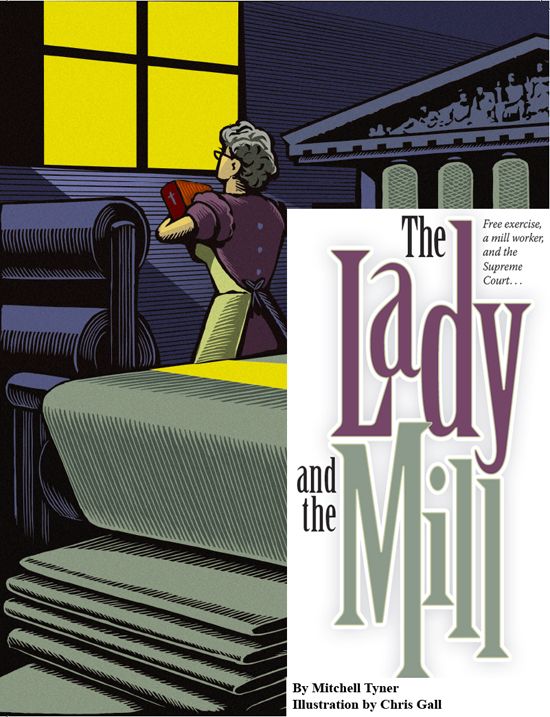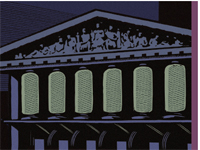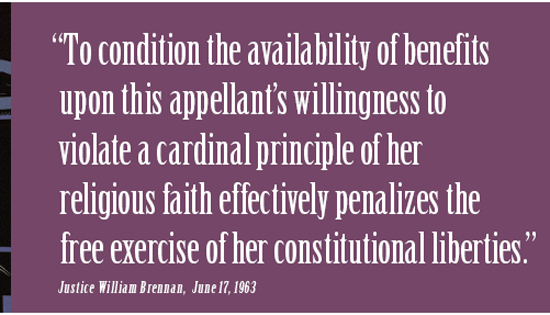The Lady and the Mill
Mitchell A. Tyner July/August 2008
Supreme Court cases of great import often involve unexpected, almost plebeian, subjects. In the area of interstate commerce, it was milk, and the regulation of its production and transport. In the area of the free exercise of religion clause, it was unemployment benefits. Here's how it happened.
Adeile Sherbert was only 19 years old when she went to work for the Beaumont plant of Spartan Mills, in Greenville, South Carolina. She worked there for 35 years, until, in 1959, she was fired.
Two years before, Sherbert became a member of the Seventh-day Adventist Church. As such, she observed the Sabbath from sunset Friday until sunset Saturday, during which time she was conscientiously unable to perform secular work.
In early 1959 the Beaumont plant went to a six-day schedule, Monday through Saturday. Sherbert's request for accommodation of her Sabbath observance was refused, and after several weeks of missing Saturday assignments she was fired for failure to report for work. She applied for unemployment benefits, which were denied because, under South Carolina law, she had to show that she was available to work any available job for which she was qualified. Jobs were available, but they all required Saturday work, so Sherbert was disqualified as unavailable.
Sherbert then called her church—specifically the Carolina Conference of Seventh-day Adventists in Charlotte, North Carolina, the administrative headquarters of the church in the two states. The church had a good deal of experience with such problems, and it contacted attorney James Cobb at the law firm of Whitlock, Dockery, Ruff & Perry (which, as Ruff, Bond, Cobb, Wade & McNair, still represents the Carolina Conference) to represent both Sherbert and Sally Lloyd, another church member fired under similar circumstances. Lloyd also worked for Spartan Mills' Beaumont Division, and had done so for 19 years. In June 1959 she was notified that she would be required to work on Saturday. When she refused to do so, she was fired.
Cobb and his firm had a head start on these two cases, as they had litigated a similar case in North Carolina a few years earlier. In that case, Imogene Miller had worked for Cannon Mills in Salisbury, North Carolina, for 13 years. She, like Sherbert and Lloyd, became a Seventh-day Adventist and began to observe the Sabbath. After missing work on Saturday, she was discharged. Miller's application for unemployment benefits was denied and the denial was upheld by a trial court, but the Supreme Court of North Carolina reversed. The applicable North Carolina statute required that the claimant be available for suitable work, and that in determining whether work is suitable for an individual, the commission should consider the degree of risk involved to her health, safety, and morals. The court reasoned that "to have forced the claimant to work on her Sabbath would have been contrary to the intent and purpose of the statute."
Cobb had good reason to believe that Lloyd and Sherbertwould reach a similar resolution in South Carolina, because 30 states and territories had reached similar results, and none had held to the contrary1.
The next step was to take both Sherbert and Lloyd to the South Carolina Court of Common Pleas, where the cases were heard on March 29, 1960. Cobb and local counsel Frank Lyles faced a problem: a 1956 case involving an Adventist named Pierce W. Strange, fired because of Sabbath observance and denied unemployment benefits. The Strange case was not heard in Spartanburg, but nearby, in Greenville, where Judge Robert R. Moss wrote an opinion upholding the denial of benefits. Moss's opinion was unreported, and it was only the decision of a single judge, but the South Carolina Employment Security Commission had continued to rely on it. There was worse news: Since writing Strange, Judge Moss had been elevated to the state supreme court—the court that would hear an appeal of Lloyd and Sherbert.
The decision came down June 28, 1960. Quoting Strange, the court found that good cause for termination and misconduct connected with the work need "not have any relation to censurable conduct. When the motivating reason for the termination of employment stems from considerations personal to the employee, the fact that the employee pursues the course which society would generally approve, does not necessarily mean that it amounts to 'good cause.'" In a seven-page decision, five pages quote from or refer to Judge Moss's opinion in Strange. No mention was made of Miller or the decisions of the 29 states that agreed with it.
By August 1960 the decision was made to appeal only Sherbert, and not Lloyd. All parties agreed to appeal only one of the two and to abide by the result in either.
Sherbert was heard by South Carolina Supreme Court on February 12, 1962. During the delay, the bad luck had continued: One of the five justices on the court died, and he was replaced by the same Judge Lewis who had ruled against Sherbert at the trial court level. Lewis would take no part in the consideration of Sherbert, but one of the remaining four was still judge, now Justice Moss, the author of the opinion in the lower court in Strange, which was relied on by Judge Lewis in Sherbert.

Cobb and the team had more worries: the United States Supreme Court had just upheld the constitutionality of Sunday-closing laws. One of the cases2 involved a tailor, named Abraham Braunfeld, an Orthodox Jew, who challenged the Sunday closing requirement because it, in effect, caused him to close two days a week while his competitors closed on only one. The Court ruled against Braunfeld, reasoning that "the [Sunday-closing] statute . . . does not make criminal the holding of any religious belief or opinion, nor does it force anyone to embrace any religious belief or to say or believe anything in conflict with his religious tenets." But Braunfeld also held that "if the purpose or effect of a law is to impede the observance of one or all religions . . . that law is constitutionally invalid even though the burden may be characterized as being only indirect." Cobb was wondering how that might ultimately affect Sherbert. As later events would show, his concern was perceptive.
The case presented to the state supreme court made note of an unusual provision of the statute: "[N]o employee shall be required to work on Sunday who is conscientiously opposed to Sunday work and if any employee should refuse to work on Sunday on account of conscientious or physical objections he shall not jeopardize his seniority rights by such refusal or be discriminated against in any other manner. . . ." Protection of one religious practice but not another presented an argument that the statute deprived Sabbatarians of constitutionally mandated equal protection of law. After all, the U.S. Supreme Court had recently held that "neither a state nor the Federal Government can set up a church. Neither can pass laws which . . . prefer one religion over another."3
The South Carolina Supreme Court decision was released May 17, 1962. The majority opinion, affirming the lower court, was written by none other than Justice Moss, who, as a lower court judge, had earlier rendered the decision in Strange. Sherbert was on its way to the highest court in the land.
Eleven days later the officers of the General Conference of Seventh-day Adventists, the church's world headquarters, voted to support appeal to the U.S. Supreme Court. State and regional offices of the church agreed to split the expense between the three levels.
On December 17, 1962, the Supreme Court of the United States granted review to Sherbert. The legal team, which now included William D. Donnelly, a constitutional law specialist from Washington, D.C., who had been brought aboard at the state supreme court level in anticipation of further appeal, went straight to the task of writing a brief that emphasized three issues: free exercise, due process, and equal protection.
Seven months later, on June 17, 1963, the Supreme Court released its decision.4 The majority opinion, holding that the denial of benefits to Sherbert violated the free exercise clause, was written and read by Justice William Brennan and joined by Chief Justice Earl Warren and Justices Hugo Black, Tom Clark, and Arthur Goldberg. Justice William O. Douglas concurred in the judgment as did Justice Potter Stewart. Justice John Harlan dissented, joined by Justice Byron White.

Brennan began by acknowledging that the Court had in the past rejected free exercise challenges to governmental regulation of acts prompted by religion (a reference to Braunfeld). But, he wrote, the conduct so regulated "invariably posed some substantial threat to public safety, peace or order."5 Sherbert's action certainly did not, and thus was not the type of religiously motivated conduct within the reach of state legislation. Therefore, if the denial of benefits was to stand, it must be either because the disqualification was not an infringement or because the infringement was justified by a compelling public interest.
Brennan then easily found that the denial of benefits was a burden. In words cited many times since, Brennan wrote: "The ruling forces her to choose between following the precepts of her religion and forfeiting benefits, on the one hand, and abandoning one of the precepts of her religion in order to accept work, on the other hand. Governmental imposition of such a choice puts the same kind of burden upon the free exercise of religion as would a fine imposed against appellant for her Saturday worship."6 "To condition the availability of benefits upon this appellant's willingness to violate a cardinal principle of her religious faith effectively penalizes the free exercise of her constitutional liberties."7
It was significant to Brennan that South Carolina "expressly saves the Sunday worshipper from having to make the kind of choice which we here hold infringes the Sabbatarian's religious liberty."8 "The unconstitutionality of the disqualification . . . is thus compounded by the religious discrimination which South Carolina's general statutory scheme necessarily effects."9
Next, Brennan found that no compelling interest had been advanced to justify the denial. The state interest was not similar to that found in Braunfeld, where a Sunday-closing law was saved by a strong state interest in providing one uniform day of rest for all workers.
Finally, Brennan anticipated the concerns of the dissenters by arguing that the decision did not foster the establishment of a religion. For Brennan, the extension of benefits was nothing more than the governmental obligation of religious neutrality.
Justice Douglas's concurrence was a short argument that the result did not present an establishment clause problem. He then reminded readers that he had dissented in Braunfeld.
Justice Stewart's concurrence took a very different approach. He argued that the case was an example of the inconsistency between the Court's establishment clause and free exercise clause cases. To Stewart (and many others since) previous decisions read together present "many situations where legitimate claims under the free exercise clause will run into [a] head-on collision with the Court's insensitive and sterile construction of the establishment clause."10 It seemed to Stewart that the free exercise clause was being interpreted to require what the establishment clause forbade.
Stewart took a broad view of free exercise clause rights: "I think that the guarantee of religious liberty embodied in the free exercise clause affirmatively requires government to create an atmosphere of hospitality and accommodation to individual belief or disbelief. In short, I think our Constitution commands the positive protection by government of religious freedom."11 Stewart also observed that the Court showed insensitivity in Braunfeld to the demands of the free exercise clause, and that this decision (Sherbert) could not stand consistently with Braunfeld, which was wrongly decided and should be overruled.
Justice Marian's dissent shows a very different concept of discrimination: it is actionable only if intentional. For Harlan, the intent of the state law was clearly to provide no relief for those unavailable for work for purely personal reasons. That these arose from religious conviction was wholly irrelevant. For the Court to require the state to carve out an exception for religion, in Harlan's view, overruled Braunfeld. Singling out of religion for special treatment violates the establishment clause. A state could choose to do it but can't be required to do so, and "those situations in which the Constitution may require special treatment on account of religion are, in my view, few and far between."12 Harlan's view had ominous overtones of what was to come 27 years later.
In Sherbert, the Court for the first time enunciated a clear framework for analyzing free exercise clause cases: a state-imposed burden on religion was acceptable only if it was required by a compelling public interest that could be met by no less intrusive method. In legal parlance, the Court applied strict scrutiny to free exercise claims. The Sherbert test was of great utility, as shown by the fact that as of late 2007, it had been cited 6,827 times in other cases, both state and federal, most of which resulted in the extension of religious freedom and equality.
That ended in 1990 when the ominous overtones in Justice Harlan's Sherbert dissent became reality. The Court enunciated a very different interpretation of the free exercise clause: There need be no exception granted for religiously motivated conduct in violation of a statute if that statute was (1) a law of general applicability that (2) was facially neutral toward religion.13 In one breathtaking action the Court swept away the majority of the protection Sherbert had provided. Under Sherbert, the state had to prove that its burdening of religion was required by a public interest of the very highest order—no easy task. Under the new interpretation the claimant must show that the burden was intentional—again, no easy task. It is telling that since 1990 the Court has ruled in favor of free exercise claimants only twice, in circumstances that clearly showed intent to discriminate.14 There is no longer protection from unintended (but onerous) state burdens on religious conduct.
As a practical matter, did it make that much difference? Consider two real situations. In the late 1970s (before Employment Division v. Smith), a Seventh-day Adventist in Kentucky was prevented from taking the examination for a master plumber's license because the examination was always given on Saturday. The applicant's counsel asked the state attorney general's office if there really was a compelling public interest in giving the examination in many locations but always on Saturday. The result was a quick offer to work something out. The applicant took the examination and received his license.
Today, several states in the southeastern United States jointly administer their examination for a license to practice dentistry. The examination takes three days, is given in several locations in the states involved, but is always given Friday through Sunday. When counsel for several Seventh-day Adventist applicants asked if there was a reason the examination could not be given at least once on other days, he was told "Sherbert is no longer applicable. We don't have to show a compelling interest. We don't have to do anything for your clients." Unfortunately, they are right.
Efforts to undo the damage done in Smith have been frustrated. A broad coalition of religious and civil rights groups wrote, and the Congress passed, the Religious Freedom Restoration Act of 1993, which restored the Sherbert test.15 But in 1997 the Court ruled, on federalism grounds, that RFRA was applicable to the federal government but not to the states.16 The coalition tried again and produced the Religious Liberty Protection Act, which was never introduced in Congress because the religious community could not agree internally whether or not religious conviction should constitute a legitimate defense to a charge of violating equality rights. Then, at the urging of Senators Kennedy and Hatch, the group prepared a bill focused on the two most prevalent religious liberty issues. That bill became the Religious Land Use and Institutionalized Persons Act of 2000.17 RLUIPA restores strict scrutiny to governmental actions involving zoning and prisons, but provides no relief in other areas. And RLUIPA is now under attack as being a violation of the establishment clause. The friction between the two religion clauses referred to by Justice Stewart in Sherbert has never been resolved. As the debate continues, Sherbert remains that moment when the Supreme Court gave the greatest protection to those whose religious practices are impinged on by government action.
Mitchell Tyner was an associate general counsel for the Seventh-day Adventist Church for many years. He specialized in workplace accommodation issues. He writes from Silver Spring, Maryland.
1 Arizona, Alabama, California, Colorado, Connecticut, Delaware, District of Columbia, Georgia, Idaho, Illinois, Hawaii, Kansas, Kentucky, Louisiana, Maine, Maryland, Massachusetts, Michigan, Montana, Nebraska, Nevada, New Jersey, New York, Ohio, Oregon, Pennsylvania, Tennessee, Virginia, Washington, Wisconsin
2 Braunfeld v. Brown, 366 U.S. 599 (1961).
3 Everson v. Board of Education; 330 U.S. 1 (1947).
4 Sherbert v. Verner, 374 U.S. 398 (1963).
5 Ibid., 374, U.S. 398, 403 (1963).
6 Ibid., 374 ,U.S. 398, 404 (1963).
7 Ibid., 374 U.S. 398, 406 (1963).
8 Ibid.
9 Ibid.
10 Ibid., 374, U.S. 398, 414 (1963).
11Ibid. 374 U.S. 398, 415 (1963).
12 Ibid., 374 U.S. 398, 423 (1963).
13 Employment Division v. Smith, 494 U.S. 872 (1990).
14 Church of the Lukumi Babalu Aye v. Hialeah, 508 U.S. 520 (1993);
Gonzales v. O Centro Espirita Beneficiente Uniao do Vegetal, 546 U.S. 418 (2006).
15 42 U.S.C. 2000bb et seq.
16 Boerne v. Flores, 521 U. S. 507 (1997).
17 42 U.S.C. 2000cc et seq.